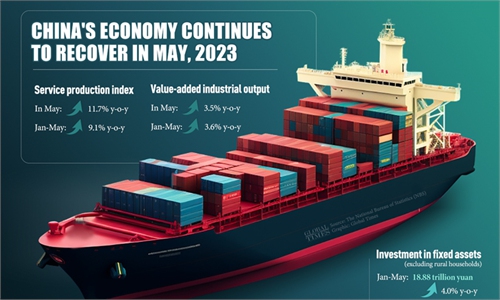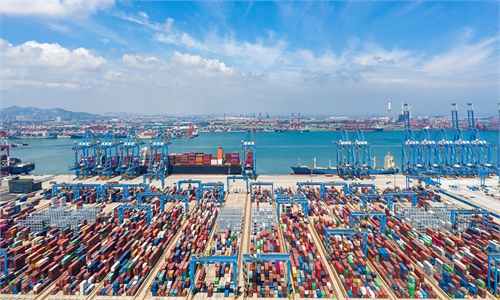China studies policy priorities to promote sustained economic recovery; observers expect more stimulus measures
‘Stabilizing demand’ in focus, more stimuli in pipeline

Residents dine out in a restaurant in the Nanqiang Street of Kunming, southwest China's Yunnan Province, Jan. 11, 2023. The street, located in downtown Kunming, has seen a robust recovery of the nighttime economy. Tourists here can experience local food culture and nightlife of Kunming.(Photo: Xinhua)
Chinese Premier Li Qiang on Friday chaired an executive meeting of the State Council, China's cabinet, to study a slew of policy measures aimed at promoting sustained economic recovery, with a particular emphasis on expanding effective demand, strengthening the real economy, and preventing and resolving risks in key areas.
It is also the last State Council executive meeting chaired by Li before he heads off for official visits to Germany and France starting from June 18.
The meeting has laid out China's policy priorities in the next stage to stabilize and further inject impetus into China's economic recovery. It also comes after China on Thursday released key economic indexes in May, which showed a moderate recovery was underway even though issues of lopsidedness persist due to multiple downward pressures.
Observers believe that more stimulus measures are in the pipeline to further rev up the recovery momentum, in particular concerning the consumption of large commodities and expanding the construction of basic infrastructure, after the recent cuts in China's key interest rates.
The meeting pointed out that China's overall economic performance is steadily improving. But at the same time, the external environment is becoming increasingly complex and challenging, with global trade and investment slowing down, directly impacting China's economic recovery process.
In response to the changing economic situation, the meeting emphasized the need for more effective measures to enhance development momentum, optimize economic structure, and promote sustained economic recovery and improvement.
An action plan to increase support for financing of technology-based enterprises was also approved during the meeting, which shows China's extensive support for tech start-ups and making the finance sector better serve the real economy.
The plan emphasizes the optimization of financial institutions' products, markets, and service systems to meet the diverse needs of technology-based enterprises at different stages.
The capital market has an inherent advantage in fostering high-level technological self-reliance, according to observers. The new action plan will further support and strengthen science and innovation-oriented enterprises by leveraging the capital market, promoting a positive "technology-industry-finance" cycle.
The key takeaways from the meeting add to a bunch of policy focuses listed by the National Development and Reform Commission (NDRC), China's top economic planner, at a press briefing in Beijing on Friday.
NDRC spokesperson Meng Wei said on Friday that China will promptly formulate policies that restore and expand consumption, continuously improve the consumption environment, and release the potential of service consumption.
Other policies emphasize fronts include accelerating the implementation of 102 major projects of the 14th Five-year Plan (2021-25), promoting the construction of key basic infrastructures and new types of basic infrastructure, scaling up efforts to attract and utilize foreign investment, stabilizing the fundamentals of foreign trade, as well as expanding employment channels for college graduates.
"It is normal to see temporary fluctuation during the economic recovery process, judging from domestic and external development. In fact, it is important to form a complete understanding of China's economic situation not only from the current status, but also from a long-term perspective," Meng stressed.
She noted that in the long term, the positive recovery trend of China's economy remains solid despite downward pressures such as insufficient market demand and internal drives.
In May, China's economy showed a certain softness from April.
Social retails, a key gauge of China's consumption, jumped 12.7 percent year-on-year in May, slowing 5.7 percentage points from April. Meanwhile, the 3.5-percent industrial output expansion in May also slowed from a 5.6 percent year-on-year growth in April.
Zhou Maohua, an economist at Everbright Bank, told the Global Times on Friday that Chinese policies will concentrate on "stabilizing demand" in the next stage, mostly in consumption and the real estate sector.
Chinese policymakers are expected to put forward more preferential policies in the consumption of bulk commodities such as new-energy vehicles (NEVs), smart home appliances and green building materials, observers said.
There is also a sense of urgency for shoring up consumption, as rooms for policy maneuvering are ample and consumer prices remain low, they noted.
Tao Chuan, chief macro economy analyst from Soochow Securities, suggested that the country further ease its policy to release housing demand in first-tier and second-tier cities. "In terms of basic infrastructure construction, we also expect more financial instrument to be launched, rather than special treasury bonds, to channel more capital," Tao said in a statement sent to the Global Times.
"With the continuous manifestation of the macro economy policy, gradual improvement in market demand, and the optimization of supply side structure, it is believed that China's economic development drive will continue strengthening," Meng said.
Financial services company UBS on Friday revised down its China 2023 GDP growth forecast to 5.2 percent from the previous 5.7 percent, citing softness in the May data.
But Chinese observers said this view is overly pessimistic. They estimated that China's economic drives are likely to gear up in the third quarter, propelling the second-half economy to achieve a growth rate of between 5 percent and 6 percent. That will also make the whole-year GDP expansion land well above the annual target of 5 percent.



